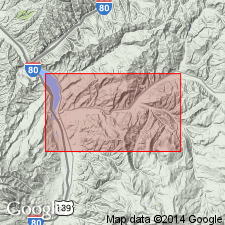
- Usage in publication:
-
- Dry Hollow member
- Modifications:
-
- Named
- Dominant lithology:
-
- Shale
- Sandstone
- Conglomerate
- Coal
- AAPG geologic province:
-
- Central Western Overthrust
Summary:
Named as a member (one of ten) of the Frontier formation for Dry Hollow 1 1/2 mi northeast of Coalville, Summit Co, UT on the Uinta uplift. No type locality given. Unconformably overlies Oyster Ridge member of Frontier. Underlies Grass Creek member (new) of Frontier. Cross sections. Correlation chart. Name has been used in earlier reports but applied only to the coal-bearing rocks. Consists in this report of a basal conglomerate, a lower shaly "interval" 880 ft thick, 90 ft of carbonaceous coal-bearing "rocks," and a prominent white, cliff-forming sandstone 200 ft thick. The "lower" sequence is red to brown silty shale, thin brown sandstone, and lenses of conglomerate considered fluviatile in origin. The carbonaceous unit has coal beds 1 to 3 ft thick. The upper sandstone forms the northwest and east flanks of the Coalville anticline. Total thickness not clearly stated. Correlated with the uppermost part of the Frontier of Cumberland Gap, Lincoln Co, WY in the Greater Green River basin. Limit of nomenclature use between Coalville and Cumberland Gap areas not stated. Assigned to the lower part of the Coniacian, Late Cretaceous.
Source: GNU records (USGS DDS-6; Denver GNULEX).
For more information, please contact Nancy Stamm, Geologic Names Committee Secretary.
Asterisk (*) indicates published by U.S. Geological Survey authors.
"No current usage" (†) implies that a name has been abandoned or has fallen into disuse. Former usage and, if known, replacement name given in parentheses ( ).
Slash (/) indicates name conflicts with nomenclatural guidelines (CSN, 1933; ACSN, 1961, 1970; NACSN, 1983, 2005, 2021). May be explained within brackets ([ ]).

